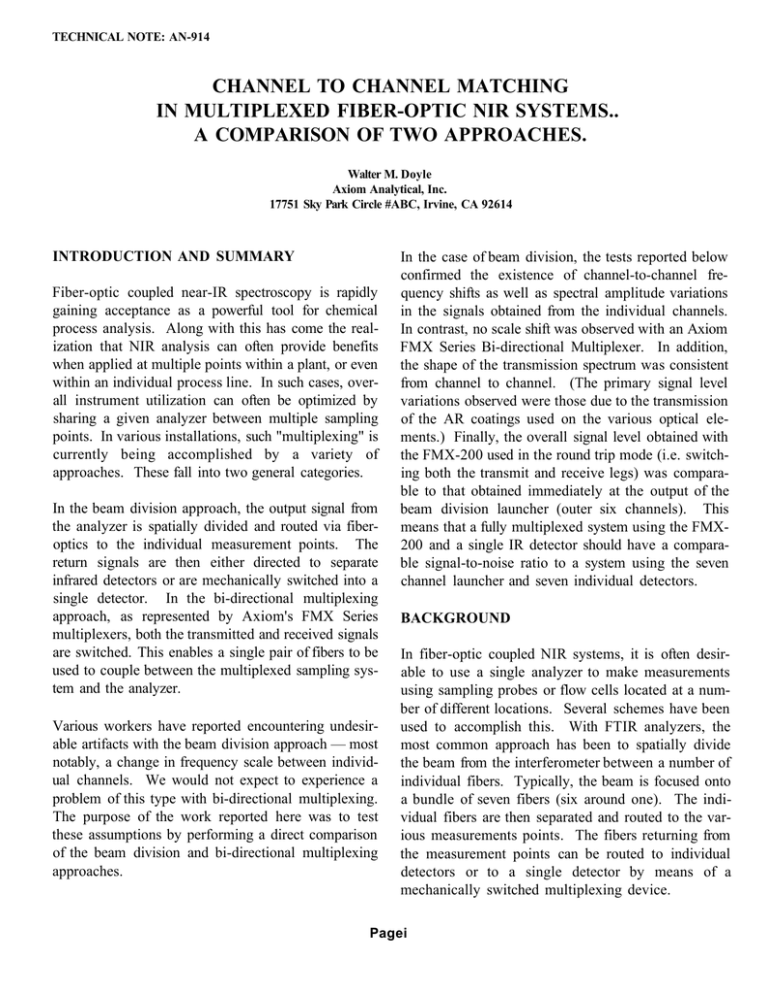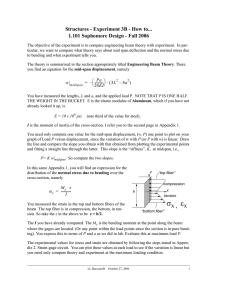channel to channel matching in multiplexed fiber
advertisement

TECHNICAL NOTE: AN-914 CHANNEL TO CHANNEL MATCHING IN MULTIPLEXED FIBER-OPTIC NIR SYSTEMS.. A COMPARISON OF TWO APPROACHES. Walter M. Doyle Axiom Analytical, Inc. 17751 Sky Park Circle #ABC, Irvine, CA 92614 INTRODUCTION AND SUMMARY Fiber-optic coupled near-IR spectroscopy is rapidly gaining acceptance as a powerful tool for chemical process analysis. Along with this has come the realization that NIR analysis can often provide benefits when applied at multiple points within a plant, or even within an individual process line. In such cases, overall instrument utilization can often be optimized by sharing a given analyzer between multiple sampling points. In various installations, such "multiplexing" is currently being accomplished by a variety of approaches. These fall into two general categories. In the beam division approach, the output signal from the analyzer is spatially divided and routed via fiberoptics to the individual measurement points. The return signals are then either directed to separate infrared detectors or are mechanically switched into a single detector. In the bi-directional multiplexing approach, as represented by Axiom's FMX Series multiplexers, both the transmitted and received signals are switched. This enables a single pair of fibers to be used to couple between the multiplexed sampling system and the analyzer. Various workers have reported encountering undesirable artifacts with the beam division approach — most notably, a change in frequency scale between individual channels. We would not expect to experience a problem of this type with bi-directional multiplexing. The purpose of the work reported here was to test these assumptions by performing a direct comparison of the beam division and bi-directional multiplexing approaches. In the case of beam division, the tests reported below confirmed the existence of channel-to-channel frequency shifts as well as spectral amplitude variations in the signals obtained from the individual channels. In contrast, no scale shift was observed with an Axiom FMX Series Bi-directional Multiplexer. In addition, the shape of the transmission spectrum was consistent from channel to channel. (The primary signal level variations observed were those due to the transmission of the AR coatings used on the various optical elements.) Finally, the overall signal level obtained with the FMX-200 used in the round trip mode (i.e. switching both the transmit and receive legs) was comparable to that obtained immediately at the output of the beam division launcher (outer six channels). This means that a fully multiplexed system using the FMX200 and a single IR detector should have a comparable signal-to-noise ratio to a system using the seven channel launcher and seven individual detectors. BACKGROUND In fiber-optic coupled NIR systems, it is often desirable to use a single analyzer to make measurements using sampling probes or flow cells located at a number of different locations. Several schemes have been used to accomplish this. With FTIR analyzers, the most common approach has been to spatially divide the beam from the interferometer between a number of individual fibers. Typically, the beam is focused onto a bundle of seven fibers (six around one). The individual fibers are then separated and routed to the various measurements points. The fibers returning from the measurement points can be routed to individual detectors or to a single detector by means of a mechanically switched multiplexing device. Pagei In principle, the beam division approach has a significant potential defect in that, if the fiber bundle is placed in the focal plane of an optical element, the radiation reaching the individual fibers will have traveled at different angles in the nominally collimated region of the system. With FTIR analyzers, differences in propagation angle in the interferometer will lead to variations in both frequency scale and resolution. Both of these effects can be troublesome in NIR analysis systems being used in demanding applications. The Axiom FMX-200 bi-directional multiplexer (patent pending) uses a pair of unique retro-prisms to switch both the transmitted and received beams in a Near-IR system between up to sixteen measurement channels. In using the FMX-200, the interferometer beam is first launched into a single fiber by means of a suitable fiber coupler such as Axiom model FAC100. This fiber effectively acts as abeam scrambler so that rays traveling at different angles in the interferometer are fully randomized by the time they reach the multiplexer. Thus, we would not expect to see a the frequency scale shift or resolution differences when using the FMX-200. EXPERIMENTAL METHOD A: Beam Division Launch Module The setup used to test the beam division launch module is illustrated in Figure 1. The launch module was coupled directly to the output of an Analect Diamond20 FTIR spectrometer and a 1 meter length of 600 jam diameter fiber was used to connect the channel being monitored to a TE cooled InAs detector. The same fiber and detector were used for all measurements. The operation was optimized by first centering the module as a whole in the interferometer beam and then fine-tuning its lens position to maximize the signal obtained with the coupling fiber attached to the center connector. We then recorded the signal obtained with the detector fiber connected, in turn, to each of the output channel ports. These were ratioed Figure 1: Experimental setup for the beam division launch module test. against a reference spectrum obtained with the receiving fiber attached to an FAC-100 Axiot to fiber coupler mounted at the interferometer output. We next studied the performance of each individual channel by first obtaining a background spectrum through the channel and then measuring the absorbance spectrum of a sample of polystyrene mounted at the input of the launch module. Finally, these spectra were subtracted from each other to assess any frequency shift effects. B: FMX-200 Bi-Directional Multiplexer For these tests, an FAC-100 coupler was mounted on the interferometer output. This was coupled to the common input connector of the FMX-210 by a 1 meter length of 600 urn diameter fiber, (the experimental setup is illustrated in Figure 2). A second 1 meter length of identical fiber was used to couple to the same detector used for part A. The round trip transmission of each channel was measured by attaching a fiber loop between the transmit and receive connectors corresponding to that channel. Again, the performance of each channel was studied by first taking a background spectrum through the Page 2 comparable to the single pass transmission of the seven channel launcher. We thus can expect the performance obtained with the FMX and a single detector to comparable to that obtained with the seven channel launcher using individual detectors for each channel. Figure 5 is the transmission spectrum of a 1 mm thick sheet of polystyrene as measured through Channel 1 of the FMX. Figure 6 gives the result of a series of subtractions of polystyrene spectra obtained with various channels of the seven channel launcher. The channels are indicated next to each trace. The derivative like spectra are the result of frequency shifts between the channels. Figure 2: Experimental setup for the bi-directional multiplexer test. channel and then measuring the spectrum of the polystyrene sample, in this case, mounted at the input of theFAC-100 coupler. Figure 7 provides the corresponding subtraction results for the four measured channels of the FMX. No measurable frequency shifts were observed. RESULTS Figure 3 gives the measured transmission of four channels of the seven channel launch module. Here "Channel 0" refers to the central channel and Channels 1,3, and 5 are evenly spaced alternate channels. The module was adjusted for maximum signal on Channel 0. A different adjustment might have produced better matching of the other channels. However, the sensitivity of spectral transmission to lens adjustment is itself a matter for concern. Figure 4 gives the transmission of Channels 1, 3, 5 and 7 of the FMX-200 operating in the bi-directional mode. The waviness of the spectral response results from the fact that optical signal passes through a total of eight antireflection-coated surfaces in making the round trip transit. However, the overall shape is reasonably consistent from channel to channel. Figure 3: Seven channel launch module transmission. (Channels 0, 1, 3, and 5) It can be seen that the overall transmission of the JFMX-200, operating in the bi-directional mode, is Page 3 Figure 4: FMX-200 bi-directional transmission. (Channels 1, 3, 5, and 7). Figure 6: Seven channel launch module subtraction results. (Channels are indicated on the traces). Figure 5: Polystyrene spectrum (Channel 1 of the FMX-200). Figure 7: FMX-200 subtraction results (Channels 1-3, 1-5, and 1-7) Page 4





